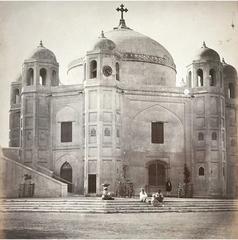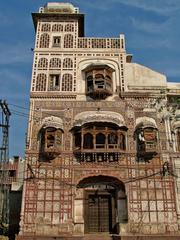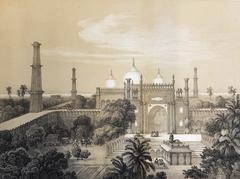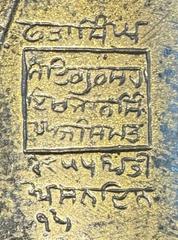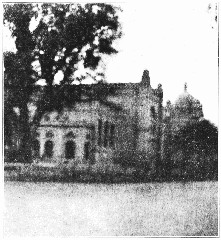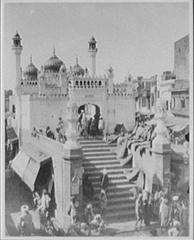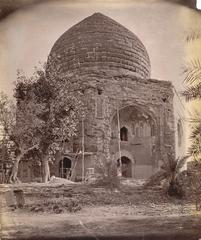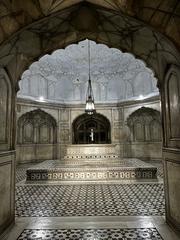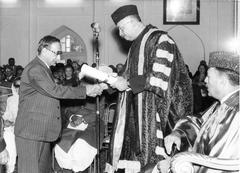
Tomb of Anarkali Visiting Hours, Tickets, and Travel Guide – Lahore Historical Sites
Date: 15/06/2025
Introduction
The Tomb of Anarkali, nestled in the historic heart of Lahore, Pakistan, is one of the city’s most evocative Mughal-era monuments. Celebrated for its architectural grandeur and legendary romance, the tomb weaves together centuries of history, myth, and cultural memory. Built in the early 17th century—widely attributed to Prince Salim (later Emperor Jahangir) in memory of the ill-fated courtesan Anarkali—the site continues to captivate locals and visitors alike. Whether you are a history buff, architecture enthusiast, or cultural explorer, the Tomb of Anarkali promises a unique journey into Lahore’s rich past (Walled City Lahore Authority; Dawn).
Table of Contents
- Introduction
- Location and Accessibility
- Historical Overview and the Legend of Anarkali
- Architectural Features
- Visiting Information (Hours, Tickets, Accessibility)
- Photography and Visitor Etiquette
- Conservation and Preservation
- Nearby Attractions and Suggested Itinerary
- Frequently Asked Questions (FAQs)
- Conclusion
- References
Location and Accessibility
The Tomb of Anarkali is located within the Punjab Civil Secretariat complex, near the bustling Anarkali Bazaar in central Lahore. Its central location makes it easily accessible by taxi, rickshaw, or public transportation via Mall Road, one of Lahore’s main thoroughfares. However, entry is regulated due to its presence within a government compound—visitors may be subject to security checks and asked to present identification (Walled City Lahore Authority).
Tip: Check with the Walled City Lahore Authority or local tourism offices for the latest hours and access protocols before your visit.
Historical Overview and the Legend of Anarkali
The Legend
The legend of Anarkali is one of South Asia’s most enduring romantic tales. According to popular accounts, Anarkali was a beautiful courtesan in Emperor Akbar’s court who fell in love with Prince Salim (later Emperor Jahangir). Their illicit romance was discovered, and Anarkali was allegedly condemned to be buried alive by Akbar—a story immortalized in film, literature, and local folklore (Dawn; Pakistan Guided Tours).
While there is little direct historical evidence for Anarkali’s existence, and her story does not appear in contemporary Mughal chronicles, the legend remains central to the tomb’s mystique and cultural resonance (Graana.com).
Construction and Historical Use
The tomb was constructed in the early 17th century, with estimates ranging from 1599 to 1615 CE. It is widely attributed to Prince Salim/Jahangir as a tribute to Anarkali. Over centuries, the structure has been repurposed—from a Sikh residence and British church (St. James’ Church) to its current use as the Punjab Archives (Wikipedia; Walled City Lahore Authority).
Architectural Features
The Tomb of Anarkali is a distinguished example of early Mughal funerary architecture:
- Octagonal Plan: Each of the eight sides measures approximately 44 feet, creating a harmonious and balanced footprint.
- Double-Layered Dome: The imposing double dome, originally clad in white marble, is both a feat of engineering and a symbol of Mughal aesthetics.
- Arched Entrances and Towers: Each side features pointed arches and semi-octagonal towers; the principal entrance faces east (Tribune).
- Marble Cenotaph: At the center, a white marble cenotaph is inscribed with the 99 names of Allah and a poignant Persian couplet often attributed to Jahangir:
“If I could behold my beloved only once, I would remain thankful to Allah till doomsday.” - Ornamental Details: Traces of original floral and geometric motifs, calligraphy, and lattice screens (jalis) evoke the craftsmanship of the Mughal era.
- Garden Setting: Historically, the tomb was set within lush gardens, remnants of which still linger on the grounds (Bagicha Blog).
Visiting Information
Visiting Hours
- Timings: 9:00 AM to 5:00 PM, Tuesday through Sunday.
Closed on Mondays and public holidays. - Access: The exterior is usually open to the public. Interior entry (housing the Punjab Archives) may require prior permission and is best arranged via official channels or guided tours.
Tickets and Entry Fees
- Exterior Access: Free of charge.
- Interior Access: May require authorization; there is no standard ticket fee, but donations toward conservation are encouraged.
Accessibility
- The site is within a government complex; expect security checks.
- The exterior is accessible, but interior areas may not be wheelchair-friendly.
- Modest dress and respectful behavior are expected.
Photography and Visitor Etiquette
- Photography: Permitted outdoors; interior photography may be restricted to protect sensitive areas.
- Etiquette: Maintain a respectful demeanor; avoid touching the cenotaph or architectural details.
- Professional Equipment: Use of tripods or commercial photography requires advance permission.
Conservation and Preservation
The tomb has undergone various uses over the centuries, including as a church and later as a government archive. Ongoing conservation efforts by the Walled City Lahore Authority aim to stabilize the structure and preserve its original Mughal elements. Visitors are encouraged to respect the site’s fragile state and support preservation efforts.
Nearby Attractions and Suggested Itinerary
- Anarkali Bazaar: Adjacent to the tomb, this market is among South Asia’s oldest, offering a vibrant mix of traditional crafts, street food, and local color (Laure Wanders).
- Lahore Museum: A short walk away, this museum is home to extensive collections of Mughal and colonial-era artifacts.
- Badshahi Mosque and Lahore Fort: Iconic Mughal landmarks within a short drive.
- Suggested Itinerary:
Morning: Visit Tomb of Anarkali and explore Anarkali Bazaar
Afternoon: Lunch at Old Anarkali Food Street
Evening: Tour Lahore Museum or Lahore Fort
Frequently Asked Questions (FAQs)
Q: What are the Tomb of Anarkali’s visiting hours?
A: Typically 9:00 AM to 5:00 PM, Tuesday–Sunday; closed Mondays and public holidays. Confirm with local authorities before visiting.
Q: Is there an entrance fee?
A: Exterior access is free; interior access may require prior permission.
Q: Are guided tours available?
A: Yes, many local operators and heritage organizations offer tours. Arrange in advance for the best access.
Q: Can I take photographs inside the tomb?
A: Photography is allowed outdoors; check for restrictions inside.
Q: Is the site accessible for people with disabilities?
A: Accessibility is limited; assistance may be required for visitors with mobility challenges.
Conclusion
The Tomb of Anarkali is a testament to Lahore’s rich Mughal legacy and the enduring power of romance and legend. With its unique octagonal design, majestic dome, and poignant story, the tomb offers a deeply rewarding experience. Careful planning—taking note of visiting hours, access protocols, and guided tour availability—will help you make the most of your visit. Don’t miss the chance to explore this living monument, the vibrant Anarkali Bazaar, and Lahore’s other historical treasures.
For the latest updates, guided tour announcements, and exclusive content, follow Lahore heritage channels and consider downloading the Audiala app to enhance your exploration.
Visual Suggestions
- Images: High-resolution photos of the tomb’s exterior, dome, marble cenotaph, and adjacent bazaar.
- Alt Tags: Use keywords like “Tomb of Anarkali Lahore,” “Mughal architecture Lahore,” and “Anarkali historical site.”
- Interactive Map: View the Tomb of Anarkali’s location on Google Maps
References and Further Reading
- Tomb of Anarkali Lahore: Visiting Hours, Tickets & Historical Guide, 2024, Walled City Lahore Authority
- The Legend of Anarkali, 2024, Dawn
- Tomb of Anarkali: Symbol of Resilience and Love, 2024, Tribune
- Interesting Facts & History of the Tomb of Anarkali, 2024, Graana.com
- Anarkali’s Tomb, 2024, Pakistan Guided Tours
- Anarkali’s Tomb: Myth, Legend and Public History, 2024, HafsaYT Medium
- Best Places to Visit in Lahore, 2024, Laure Wanders
